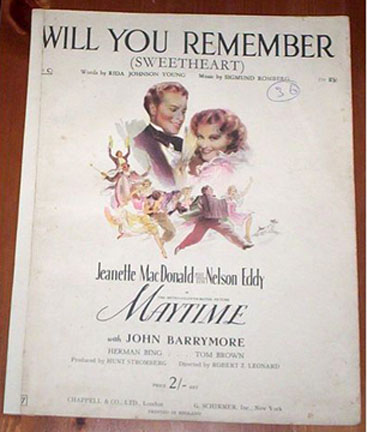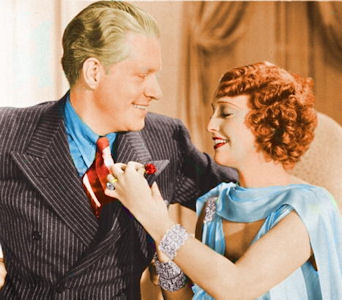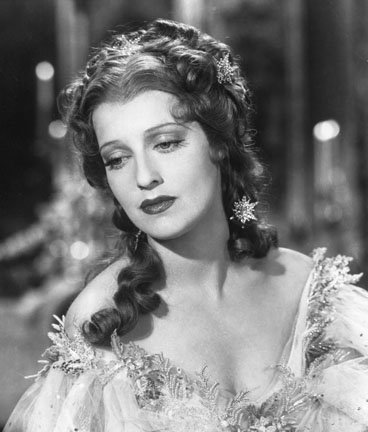
Madeline Bayless has kindly transcribed for us the two slightly different versions of “Will You Remember.”
Here is the version from the first Maytime, a production that was scrapped after the death of its producer, Irving Thalberg:
WILL YOU REMEMBER – ORIGINAL DUET
As recorded for the first “MAYTIME”
Music by Sigmund Romberg
Lyric by Rida Johnson Young
Adapted by Herbert Stothart
Nelson:
Ah, love is so sweet in the spring-time,
When two hearts are singing in May.
No years that are coming can bring time,
To make me forget, dear, this day.
I’ll love you in life’s gray December
The same as I love you to-day.
Jeanette:
My heart, ever young, will remember
The thrill it knew, this day in May.
Nelson:
Sweet-heart, sweet-heart, sweet-heart,
Will you love me ever?
Will you remember this day,
When we were happy in May,
My dearest one?
Jeanette:
Sweet-heart, sweet-heart, sweet-heart,
Though our paths may sever,
To life’s last faint ember
I will remember
Spring-time, Love-time, May.
Jeanette
Sweet-heart, sweet-heart, sweetheart,
Will you love me ever?
Nelson:
Will you remember this day,
DUET:
When we were happy in May.
My dearest one?
Jeanette:
Sweet-heart, sweet-heart, sweet-heart,
Nelson:
Though our paths may sever,
DUET:
To life’s last faint ember,
I will remember
Spring-time, Love-time, May.
***
WILL YOU REMEMBER? – Film Version recorded
September 21st 1936 for second “MAYTIME”
Music by Sigmund Romberg
Lyrics by Rida Johnson Young
Nelson:
Ah, love is so sweet in the spring-time,
When blos-soms are fra-grant in May.
No years that are com-ing can bring time,
To make me for-get, dear, this day.
Jeanette:
I’ll love you in life’s gray De-cem-ber
DUET:
The same as I love you to-day,
My heart, ev-er young, will re-mem-ber
Nelson:
The thrill it knew,
Jeanette:
that day in May.
Sweet-heart, sweet-heart, sweet-heart,
Will you love me ev-er?
DUET:
Will you re-mem-ber this day,
When we were hap-py in May,
My dear-est one?
Nelson:
Sweet-heart, sweet-heart, sweet-heart,
Though our paths may sev-er,
DUET:
To life’s last faint em-ber
Will you re-mem-ber
Spring-time, Love-time, May?
Sweet-heart, sweet-heart, sweet-heart
Though our paths may sever,
To life’s last faint ember,
Will you remember
Spring-time, Love-time, May?
***
Additional comments by Madeline Bayless:
This song is very often referred to by the opening words of the refrain which is: “SWEETHEART, SWEETHEART, SWEETHEART”. That eventually leads into the true title, “WILL YOU REMEMBER”.
Maytime was the top grossing picture for 1937! It is rated as one of the best 100 films ever made! Even today it remains popular, some 70+ years after it was released in March of 1937.
An interesting sidelight, is the names given the two leading characters when this operetta was first produced. Nelson Eddy’s character was “Dick” or “Dicky Wayne” and Jeanette’s name was “Ottilie”!
In the film version, Nelson Eddy’s name is “Paul Allison”; Jeanette’s name is “Marcia Mornay.”
The operetta was set in the 1840’s and premiered on Broadway, August 16, 1917 and ran for an astounding 492 performances. It established Romberg as a premier operetta composer.
You can listen to the first “Maytime” version of “Will You Remember” at this link.



